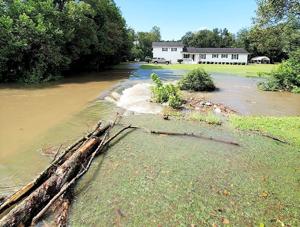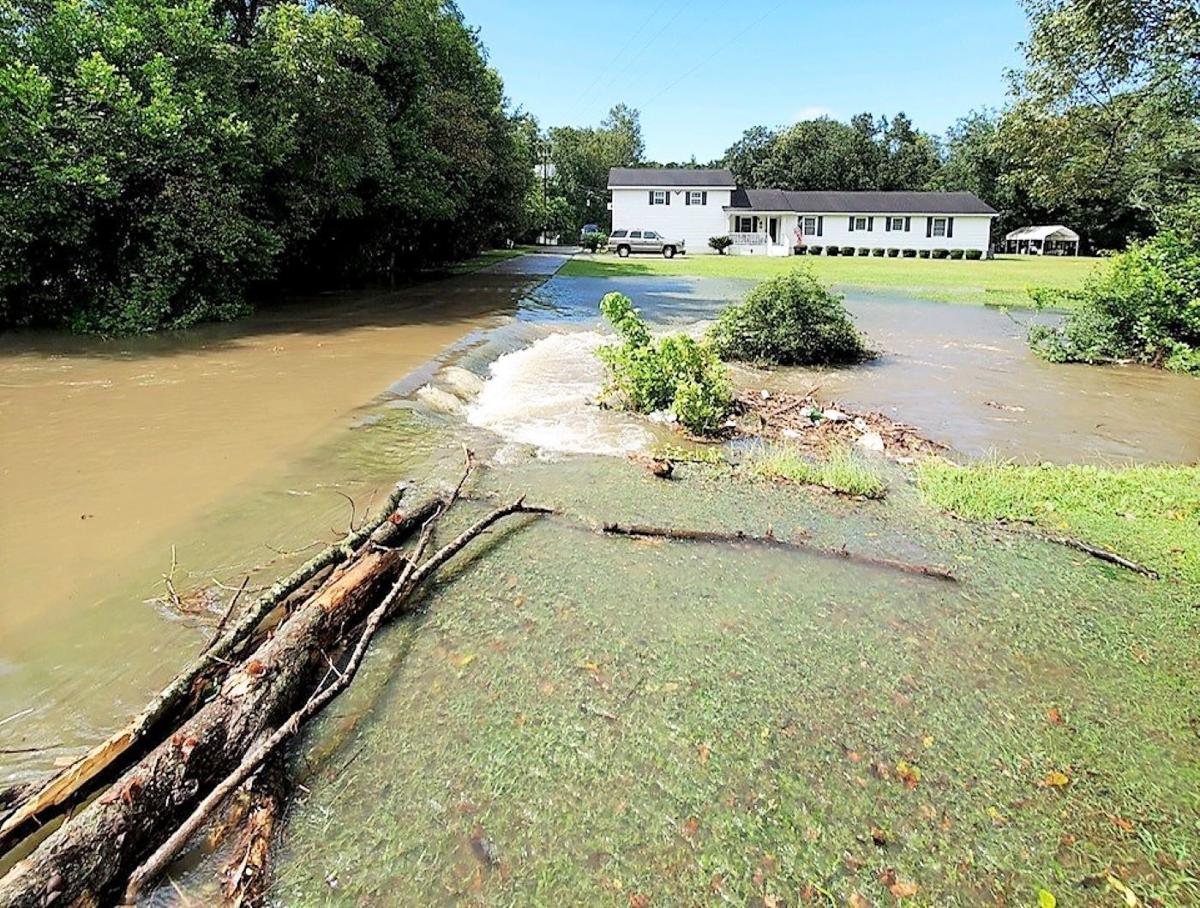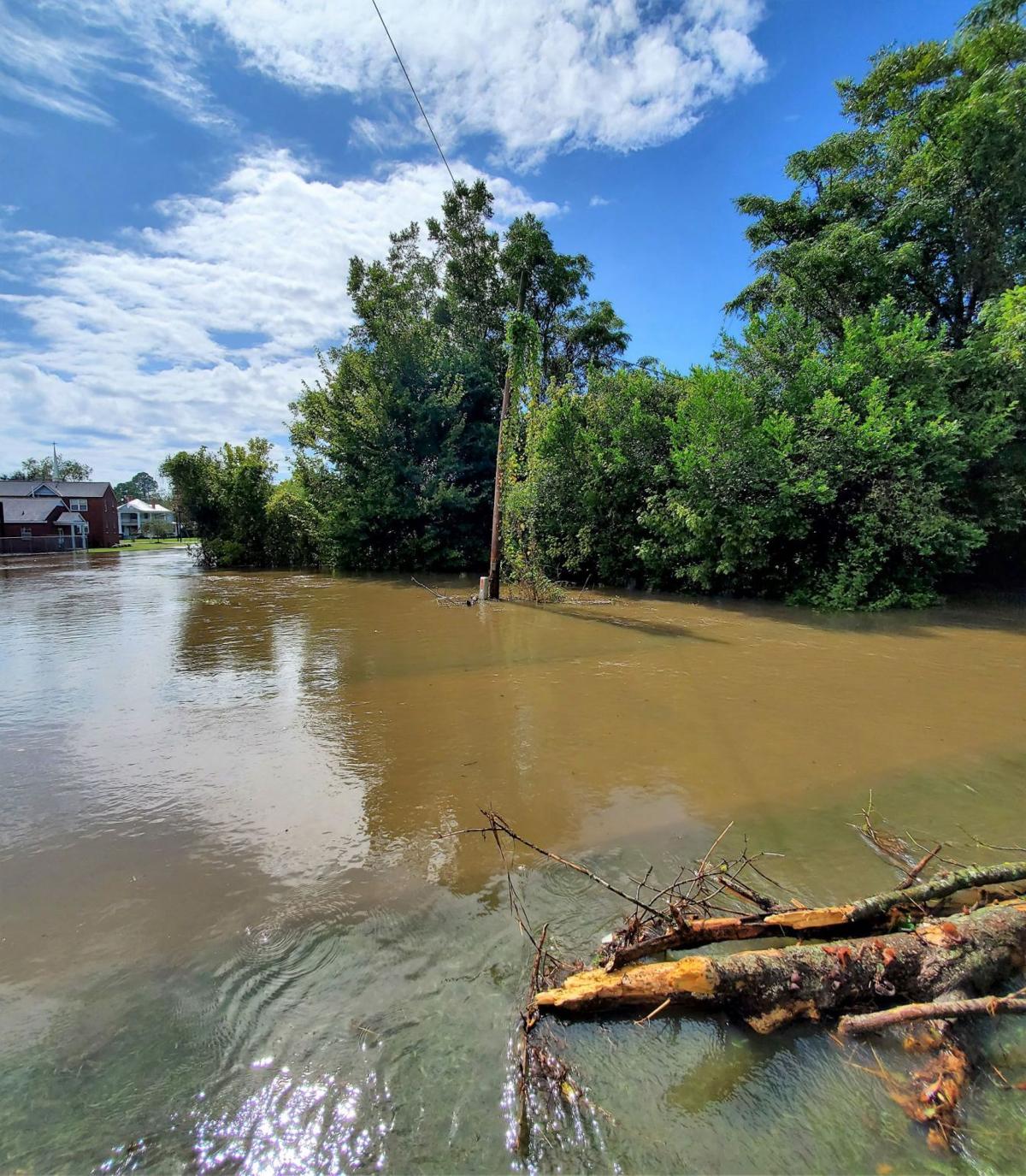
BOWMAN – When it rains, it pours. In the town of Bowman, it also floods.
At Michelle Redden’s Poplar Street residence, “Every time it rains heavily, my driveway is damaged more and more.”
Redden is worried that while she may be dealing with a damaged driveway, things could get much worse.
What if she requires emergency services? What happens if they can’t reach her due to the damaged road or floodwaters?
Redden is not alone.
Two homes on Oliver Street were surrounded by water following Tropical Storm Sally in September 2020. The storm dropped about seven inches of rain in and around the town.
Other streets that typically flood during heavy rains are Reesville Road, Dibble Street, Tupelo Street, Canal Street, Ann Street and Rail Street.
Bowman Councilman Ike Carter says flooding has been a problem in Bowman for decades, but has gotten worse over recent years.
Land development in surrounding areas – for example the construction of solar farms – has meant additional water draining into the town’s creeks and streams, Carter claims.
“They cut the land as flat as a pancake and did not put any containment ponds in,” he said.
That and the lack of ditch maintenance has combined to create the chronic flooding, he said.
Bowman flooding
There are three main drainage arteries that come through Bowman.
One is the canal by the Bowman Nature Park, one runs through the middle of town and the third is located on the Charleston side of town. Even Branch is the main stream through town.
According to a flood insurance study of the town made seven years ago by the Federal Emergency Management Agency, Bowman is located on a flat coastal plain that “has many shallow, elliptically shaped depressions of various sizes that do not drain naturally.”
The study noted that gently sloped land from Even Branch allows flooding to occur relatively easily. Longtime residents of the town have noted yards and basements have flooded, but no one could recall the ground floor level of any building flooding.
Beyond her personal property, Redden says flooding leads to fire hydrant damage, vegetation overgrowth and an increase in vermin, mosquitoes and snakes.
She is also concerned on how the flooding may impact the town’s sewer system and its water supply.
Redden says her research shows Orangeburg County owns the drainage easements for at least 39 different properties.
She says she has reached out to Orangeburg County several times, but has not had much success.
“I feel we can resolve this issue if we work together,” Redden said.
In a May 31 email, Redden asked the county to:
• Mow and clean the drainage easements.
• Treat for mosquitoes.
• Assess the drainage easements.
Blame game
Redden, like Carter, blames much of the increased water on the construction of the Palmetto Plains solar farm. The solar farm leases land from Bowman farmers Landy and Hugh Weathers. Hugh Weathers is the S.C. Commissioner of Agriculture.
Redden has questioned the design of the project and why there are no retention ponds.
She also questioned if the solar farm received a final inspection approval from the S.C. Department of Health and Environmental Control. Redden said she has asked for the information from DHEC and has never received the information requested.
DHEC Director of Media Relations Ron Aiken said a permit was issued by DHEC for the Palmetto Plains solar farm in April 2018.
“DHEC’s review for the issuance of that permit assessed that the proposed design complied with applicable state regulations for storm water management and sediment/erosion control,” Aiken said. “Once a permit was issued, the owners of the construction activity are required to hire a qualified inspector to perform weekly inspections of the sediment and erosion control best management practices for the site. These reports are maintained on the site but are not submitted to DHEC and would not be accessible to provide under FOI.”
Aiken said DHEC also performs routine inspections.
“A part of those inspections would be to verify that the permitee performed their weekly inspections,” Aiken said. “However, inspections are not performed on all permitted sites.”
“Our records indicate that no inspections were performed by DHEC at this site while it was under construction,” Aiken continued. “A notice of termination for their construction permit was issued 12/2019 based on certification signed by their engineer.”
The notice of termination certified that the site meets criteria for final stabilization and that the approved plan has been implemented, Aiken said.
Landy Weathers said flooding was a problem in Bowman, “long before anybody heard the word solar.”
“We have issues for flooding a long time before solar ever showed up on the scene,” Weathers said. “I don’t think it has anything to do with solar.”
Weathers said the real issue is the ditches in town.
“They are full of trash and are not cleaned out,” he said. “The drainage ditches need to be cleaned out. They are not maintained like they should be.”
Weathers said the owners of the equipment on the solar farm are responsible for ensuring regulations are followed.
“We just lease the property,” he said.
Cypress Creek Renewables, the owner of the solar farm, released a statement saying, “The Palmetto Plains Solar project was constructed with strict adherence to the state National Pollutant Discharge Elimination System permitting requirements, the site plan was approved by the relevant South Carolina state agencies and included erosion and sediment control measures during construction and site work.
“The project design included stormwater calculations performed by a professional engineer licensed in the state of South Carolina showing the pre-construction stormwater flow and the post-construction stormwater flow ensuring that the site would not export stormwater at a rate greater than what was always there. Project personnel performed formal weekly inspections throughout the construction process until no longer required by the state permitting authority.”
The statement continued that, “Currently, Palmetto Plains is staffed seven days a week by an experienced operations and maintenance contractor that specializes in solar power plants. The site is routinely inspected every day for any issues of concern. The site is currently is good condition with no known erosion or sediment flowing off site and there is no civil work currently in process.”
Residents’ stories
Eulinda Willis, who lives on Canal Street, says water can rise up to about two feet on the road and breaches the steps of her house when it rains.
About a year ago, the floodwaters were so high her family was stuck in their homes surrounded by water, she said.
While the water has never gotten into the house, her mother had to be rescued by boat from her home during a tropical system years ago.
“This area is bad. It is really bad. I don’t know how long we can continue like that because the water gets real high,” Willis said.
Her mother, Eunice Montague, has lived on Canal Street since 1973.
“It has been flooding here since I have been here,” Montague said. “It floods all the time.”
Willis said water has entered vehicles and caused significant damage.
“My mom sold her car because the water got so bad in her car,” she said. “The insurance paid her for it because it was flooded.”
Seven Flowers Floral Shop owner Pearlie Turkvant-Heyward said flood waters have risen up the third step of her house and prevented access to her Oliver Street business.
“When it rains, it rains,” Turkvant-Heyward said. “It is like a swamp. You cannot see the road.”
Turkvant-Heyward said she has contacted the town of Bowman, former Sen. John Matthews, the county and the state.
The S.C. Department of Transportation did partly clean out a ditch about four years ago, but the area continues to flood, she said.
Addressing the issue
Orangeburg County Administrator Harold Young said the county is aware of the problem.
The county has reached out to engineers and its Public Works staff has examined drainage canals with the intent to begin a concerted effort on cleaning out the ditches using specially designed equipment to handle such projects.
But Young said the issue is larger than ditches.
“It is about the drainage overall,” Young said.
A meeting was held in October 2020 between Orangeburg County, the Army Corps of Engineers, town officials and some residents in an effort to better grasp what can be done in a cost-effective way to help improve the flooding issues in the town.
What came out of the meeting was a preliminary assessment by the Corps.
The study revealed Even Branch has “streamflow constrictions” which impact its ability to drain properly.
The study said whether the restrictions are due to debris or sediment accumulation would require more study but concluded that culverts need to be evaluated to help reduce back water effects.
Beaver dams may also be a cause of stream blockages, according to the study.
“Results of culvert changes may only address the flooding for a limited extent upstream and other measures could be considered to further reduce water levels,” the study stated.
The study noted that removing large trees from the stream bank would require bank stabilization and that structures in the floodplain could be removed or elevated.
“It is a work in progress,” Young said, noting the county plans to engage with the Corps as well as SCDOT to further investigate the issues.
Young said the county is in the process of seeking grant funding to handle any infrastructure improvements. He said a study alone to discover the problem will cost about $60,000.
The issue is not just a county concern, Young said. The ditches are tied into state-owned ditches and the watershed, which are not the responsibility of the county.
Young said climate change has compounded the problem of flooding.
“We are getting more constant downpours like this that overwhelms the system,” Young said. Flood waters typically stay for a short period of time and then dissipate.
“The system works. It is just the capacity that needs to be built into the system to handle those downpours,” he said.
“We are doing our part,” Young continued, noting that a longer-term fix will not happen overnight.
“It takes a lot of money. Infrastructure, unfortunately, takes time. That is not what people want to hear, but it takes time to pull grants together and cost estimates,” he said.
Jeff Livasy, the Corps’ chief of programs and civil works project management, said the Charleston District conducts annual inspections of the area’s Cow Castle Creek and its tributaries.
About 38 years ago, the Corps did a “snagging and clearing” project involving the creek and tributary. The project received some federal funding.
The snagging and clearing project opened up water flow and also aimed to conduct some channel shaping to better handle water volumes.
In the short term, the SCDOT has visited the town and cleaned out several ditches. The cleaning produced a significant amount of trash as well as organic growth, Carter said.
“The people of Bowman carry some of the burden of responsibility by throwing trash into the ditches,” Carter said.
Carter said the goal is to implement smaller, less costly changes in an effort to determine if the changes will help alleviate some of the flooding concerns.
He noted at one time – about 50 years ago – there was greater official oversight of the watershed through a maintenance program. Over time, this has been lost.
“This will be a multi-year project to improve the watershed,” he said.
Carter said something needs to happen to help spur growth in the small town.
“You can’t be having the town flood,” Carter said. “If we add more houses, the street flooding won’t get better but it will get worse if we don’t have sufficient drainage capacity.”
#pu-email-form-daily-email-article { clear: both; background-color: #fff; color: #222; background-position: bottom; background-repeat: no-repeat; padding: 15px 20px; margin-bottom: 40px; border-top: 4px solid rgba(0,0,0,.8); border-bottom: 1px solid rgba(0,0,0,.2); display: none; } #pu-email-form-daily-email-article, #pu-email-form-daily-email-article p { font-family: -apple-system, BlinkMacSystemFont, “Segoe UI”, Helvetica, Arial, sans-serif, “Apple Color Emoji”, “Segoe UI Emoji”, “Segoe UI Symbol”; } #pu-email-form-daily-email-article h1 { font-size: 24px; margin: 15px 0 5px 0; font-family: “serif-ds”, Times, “Times New Roman”, serif; } #pu-email-form-daily-email-article .lead { margin-bottom: 5px; } #pu-email-form-daily-email-article .email-desc { font-size: 16px; line-height: 20px; margin-bottom: 5px; opacity: 0.7; } #pu-email-form-daily-email-article form { padding: 10px 30px 5px 30px; } #pu-email-form-daily-email-article .disclaimer { opacity: 0.5; margin-bottom: 0; line-height: 100%; } #pu-email-form-daily-email-article .disclaimer a { color: #222; text-decoration: underline; } #pu-email-form-daily-email-article .email-hammer { border-bottom: 3px solid #222; opacity: .5; display: inline-block; padding: 0 10px 5px 10px; margin-bottom: -5px; font-size: 16px; } @media (max-width: 991px) { #pu-email-form-daily-email-article form { padding: 10px 0 5px 0; } }


